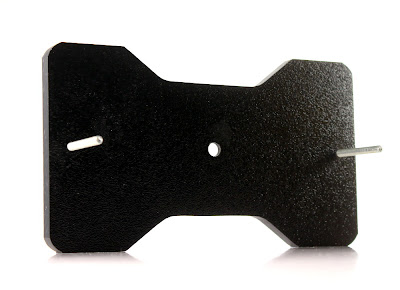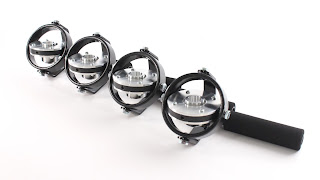DIY Camera Stabilizer Build - The Camera Stabilizer Main Tube
Working our way up the camera stabilizer from the base plate, we come to the main tube. The piece that connects everything together plays another important role. The length of the main tube above and below the gimbal affects the vertical balance of the camera stabilizer (top to bottom). The goal in the long run is to adjust the vertical balance so the center of gravity is just below the gimbal, so depending on the design, making adjustments to the main tube may be necessary.
The basic concept is the longer you make the tube below the gimbal, the more camera weight the stabilizer will support. Stabilizers designed for ultra light cameras may benefit from a longer tube above the gimbal depending on the design. The million dollar question of course is how long do I make it?
There of course is a whole bunch of math that you could run based on weights and measurements, but it's far easier to just experiment. A simple starting point is the 1to1 ratio, If you have tubes the same length above and below the gimbal, it will require just over 1 pound of counter-weight to balance a 1 pound camera. There are some design options that can come in to play to make life a little easier, like an extendable tube, or a moveable gimbal. With the help of one or more of these options, you simply need to hit the ballpark rather then really fine tuning the lengths. We'll cover the extendable main tube below, and the moveable gimbal in the next section.
Because the weight of the main tube has little affect on the inertia of the unit due to its close proximity to the gimbal (we covered this concept a bit in the Camera Stabilizer Base Plate Post), we recommend keeping it as light as possible. Strength is also a factor as it must be able to support the full weight of your camera stabilizer, so we don't typically recommend plastic for this task unless you're working on a stabilizer for an ultra light camera. Aluminum is a great option for low to mid level budgets, consider looking at carbon fiber if you've got plenty of cash to spend, and if your DIY project is on a shoe string budget, thin walled steel tubing works just fine for most projects.
 The example main tubes shown on the left are from our DIY-Garage. It's a simple thin walled steel tube with threaded plugs in each end. If you can't find plugs that fit, in many cases a cap that fits over the tube may also work.
The example main tubes shown on the left are from our DIY-Garage. It's a simple thin walled steel tube with threaded plugs in each end. If you can't find plugs that fit, in many cases a cap that fits over the tube may also work.
The 12" tube or similar could be used in a single tube design with a moveable gimbal. Or you can mix and match lengths for a dual tube split design.
One of the drawbacks of using a fixed length tube without a moveable gimbal is it relies on careful adjustment of the counter-weights to fine tune the vertical balance.
There are two key benefits of an adjustable tube:
The basic concept is the longer you make the tube below the gimbal, the more camera weight the stabilizer will support. Stabilizers designed for ultra light cameras may benefit from a longer tube above the gimbal depending on the design. The million dollar question of course is how long do I make it?
There of course is a whole bunch of math that you could run based on weights and measurements, but it's far easier to just experiment. A simple starting point is the 1to1 ratio, If you have tubes the same length above and below the gimbal, it will require just over 1 pound of counter-weight to balance a 1 pound camera. There are some design options that can come in to play to make life a little easier, like an extendable tube, or a moveable gimbal. With the help of one or more of these options, you simply need to hit the ballpark rather then really fine tuning the lengths. We'll cover the extendable main tube below, and the moveable gimbal in the next section.
Materials
Recommended:- Aluminum
- Carbon Fiber
- Thin walled steel
Because the weight of the main tube has little affect on the inertia of the unit due to its close proximity to the gimbal (we covered this concept a bit in the Camera Stabilizer Base Plate Post), we recommend keeping it as light as possible. Strength is also a factor as it must be able to support the full weight of your camera stabilizer, so we don't typically recommend plastic for this task unless you're working on a stabilizer for an ultra light camera. Aluminum is a great option for low to mid level budgets, consider looking at carbon fiber if you've got plenty of cash to spend, and if your DIY project is on a shoe string budget, thin walled steel tubing works just fine for most projects.
Design Options
There are actually several ways you can design the tube, or tubes for your DIY camera stabilizer, just keep in mind that length is important.Fixed length tubes
 The example main tubes shown on the left are from our DIY-Garage. It's a simple thin walled steel tube with threaded plugs in each end. If you can't find plugs that fit, in many cases a cap that fits over the tube may also work.
The example main tubes shown on the left are from our DIY-Garage. It's a simple thin walled steel tube with threaded plugs in each end. If you can't find plugs that fit, in many cases a cap that fits over the tube may also work.The 12" tube or similar could be used in a single tube design with a moveable gimbal. Or you can mix and match lengths for a dual tube split design.
One of the drawbacks of using a fixed length tube without a moveable gimbal is it relies on careful adjustment of the counter-weights to fine tune the vertical balance.
Extendable Tubes
The image on the left shows some of the variations in length you can achieve with an extendable tube. The extendable main tubes pictured are currently available in our DIY-Garage.There are two key benefits of an adjustable tube:
- It allows the vertical balance to be changed by simply adjusting the length of the tube.
- Greater camera weight support range can be achieved.








Comments
Post a Comment